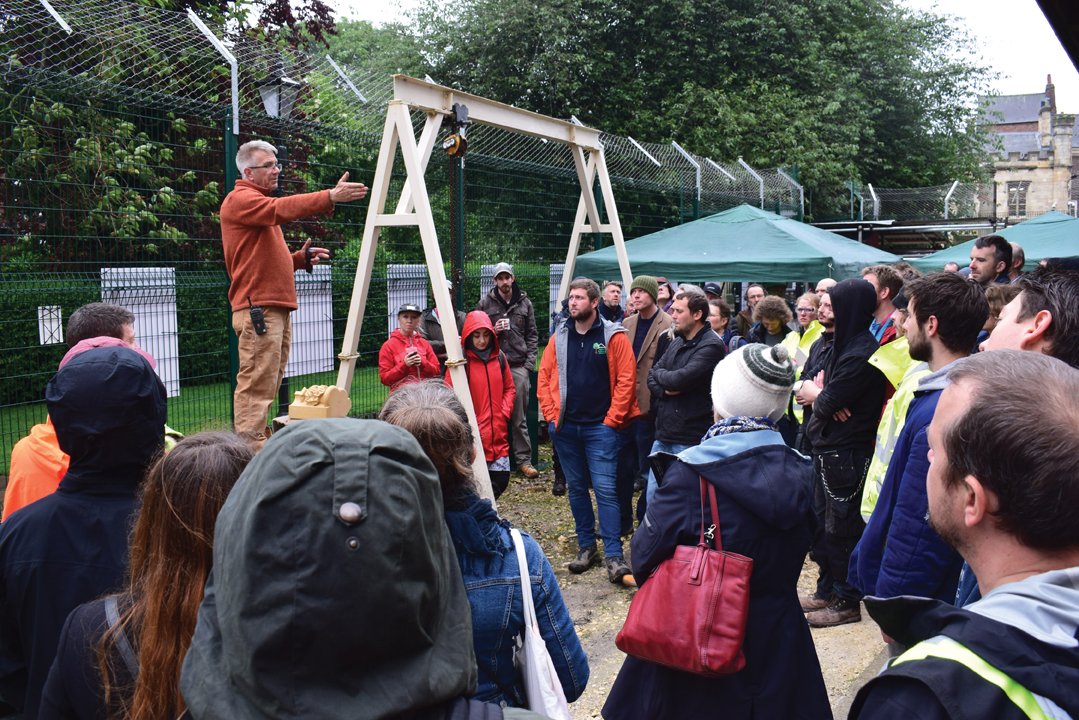Hot Mixed Limes & Traditional Mortars: Down to earth advice on a hot topic in heritage
Nigel Copsey is a hands-on conservator who was converted to the benefits of earth mortars and hot mixed lime many years ago. He has been spreading the word enthusiastically ever since and last year he shared what he has learnt in a book that has become a conservators’ bible on the subject.
Nigel Copsey is a man with a message. He preaches it zealously to enthusiastic disciples wherever he goes. His aim is to be a saviour, and what he is trying to save is the historic built heritage.
Like a latterday William Morris, the Arts & Crafts leader and founder of the Society for the Protection of Ancient Buildings (SPAB), Nigel eschews the mass produced solutions of the modern world in favour of the somehow truer, certainly earthier knowledge of the craftsmen of an earlier age – knowledge gained from practical experience and passed down through generations of initiates.
The knowledge was almost lost in the sales messages of mass production that managed to turn heads from the traditional ways with promises of quicker, easier and cheaper ways of working.
The main culprit is modern, hard cements, led by Ordinary Portland, the use of which has led to the accelerated deterioration of many a historical structure, especially those built of stone.
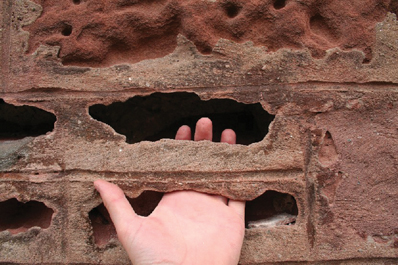
It is now widely understood that hard cement accelerates the decay of masonry by fundamentally changing the way the walls of older buildings perform, but Nigel Copsey says natural hydraulic lime can be just as damaging.
When a harder mortar was used it could no longer cope with the movement, putting strain on the masonry, which could cause it to crack. Hard cements are also less porous than the masonry and trap water in the fabric, accelerating its decay through processes such as salt crystallisation and, sometimes, freezing. The resulting loss of material can result in localised microclimates that further erode the masonry.
That is the legacy of hard cements that have taken over from lime and earth mortars since the first patent for Ordinary Portland Cement (OPC) was granted in 1824.
The use of hard cements to repair buildings constructed before that time has caused incalculable damage, and is still adding to the cost of maintaining the built heritage as the impermeable cement is removed and replaced by lime mortar. Doing just that formed part of the renovation work carried out on the Palladian bridge at Clumber Park in Nottinghamshire featured on page 14 of this issue of Natural Stone Specialist.
The message from Nigel Copsey is that traditional lime mortars are eminently workable, effectively porous, economic in use and appropriately durable.
They have been used in buildings for thousands of years. Some of the structures built with them still stand after millennia, including many examples of Greek and Roman architecture in Europe. The Americas also have examples.
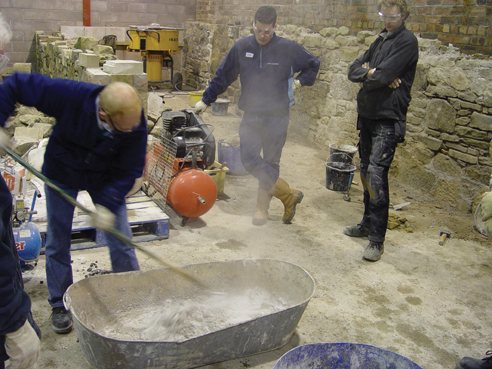 When lime is removed from a kiln it looks like what it is – lumps of burnt limestone. Burning lime (CaCO3) drives off Carbon Dioxide (CO2) to leave quicklime (CaO). When water is added to it (slaking) the lumps break down to become Ca(OH)2 and steam is driven off. Adding the right amount of water turns the burnt lime to a powder. When the powder is mixed with aggregate and more water the mix is again hot enough to produce steam, although Nigel Copsey says stories of the temperature rising to hundreds of degrees Celsius are exaggerations and the mix in fact only gets hot enough to boil water – about 100ºC.
When lime is removed from a kiln it looks like what it is – lumps of burnt limestone. Burning lime (CaCO3) drives off Carbon Dioxide (CO2) to leave quicklime (CaO). When water is added to it (slaking) the lumps break down to become Ca(OH)2 and steam is driven off. Adding the right amount of water turns the burnt lime to a powder. When the powder is mixed with aggregate and more water the mix is again hot enough to produce steam, although Nigel Copsey says stories of the temperature rising to hundreds of degrees Celsius are exaggerations and the mix in fact only gets hot enough to boil water – about 100ºC.
Lime mortars can be ideal for repair and conservation work. However, Nigel says in his book, Hot Mixed Lime and Traditional Mortars – a practical guide to their use in conservation and repair, that even the lime revival that has taken place since 1975 has not solved all the problems because of its concentration on hydraulic limes, which might take longer to cure than OP cement but can eventually become just as hard.
In the book, Nigel maintains that, historically, hydraulic limes were generally only used in wet environments, such as underground or underwater, or at least where they would be repeatedly saturated, such as harbour walls. The word ‘hydraulic’ refers to the ability of the material to set under water.
Nigel says there remains a deficit of research into the traditionally most-used hot-mix lime and earth mortars and his book seeks to redress the balance, although he concedes from time to time that the benefits of these traditional materials can be a matter of faith, albeit based on experience, rather than scientific explanation.
An example from the book comes from an explanation of hot-mix lime. He says when lime and aggregate are mixed while the heat of the slake remains, the mortar produced has significantly different characteristics to mortar made with cold – or even cooled – ingredients.
“A hot-mixed mortar tends to have greater adhesiveness, cohesiveness and enhanced workability. It is more resistant to ‘squeeze’ when used for building and yet has a greater ‘flowability’. An intimate bond, not just between the sand and lime, but between both and the added water, is achieved.”
He goes on to say: “Hot-mixing is key to character and performance, therefore, and for reasons that remain not entirely clear, although some of the slake is effected by steam, not liquid water and steam-slaking, and the distinctive behaviour of water vapour in the form of steam over liquid water in the promotion of chemical and physical reactions and bonds is probably at the root of the explanation. Early descriptions of hot-mixing in old texts stress the necessity of retaining not just heat, but steam as well.”
He does reference a substantial amount of historical literature in his book, all of which is listed in a six-page bibliography at the end that he says is “intended to encourage further reading and research” with the books representing “a resource in themselves”.
There is also an index, which is useful for a book that will be referred to time and again.
Drawing on a mixture of the historic literature, material science where it is available and industry case studies, Hot Mixed Lime and Traditional Mortars covers a multitude of aspects of the subject, including:
- An historical overview of traditional mortars
- Slaking and mixing hot-mixed lime mortars
- The essentials of pozzolans, aggregates and lime tempering
- Plasters, lime washes and sheltercoats
- The revival of interest in the use of like-for-like and compatible mortars.
The book also examines earth and earth-lime mortars and building, which makes an interesting chapter of its own covering rammed earth, cob, ‘mud and stud’ and adobe (blocks). It adds to the understanding of traditional building. For most of history people built with what was available where they wanted to build and clay-bearing subsoils are abundant and were often used as mortars throughout a wall with lime used for pointing only.
Nigel’s take on using like-for-like and compatible mortars is interesting, because determining like-for-like in mortars is not easy. The original builders would have used what their sagacity told them would be best for the job, which would not necessarily be the same throughout the building. In addition there might well have been work carried out since the building was constructed, especially re-pointing, that would have been undertaken in most instances without any reference to what was used originally – which is why so much hard cement was used after it became available to Victorian and subsequent builders.
It is arguable that an attempt to replicate original mortar mixes throughout a structure is generally futile and it might be better to use what we now believe is in the best interests of the building given the application for which the mortars are being used, albeit based on an analysis of what has been used previously.
It is a tenet of conservation that any interventions should be reversible, or at least removable, so if we discover at some time in the future there is a better way of doing it, it can be re-done, in the same way as hard cement pointing, render and plaster is now being replaced using sympathetic lime-based products.
On his website, Nigel sets out the principles by which his company, Earth Stone & Lime Company & Associates, works: “We aspire to a thoroughgoing and articulate day to day ethical practice in accordance with international conservation treaties. We place a strong emphasis upon the promotion of open, honest and unhierarchical dialogue between all those involved in a project...”
It is a recurring theme of his that architects and designers have much to learn from the practical knowledge of craftspeople and should consult them about specifications rather than dictate to them.
He says conservation is about engaging with the craft, history and cultural significance of a building or monument.
And: “We believe that there are no circumstances in which the use of ordinary portland cement mortars may be either necessary or justified in the context of a structure not originally constructed using these materials. We use lime mortars and traditional materials whose performance has been tested over centuries of use in all climates and conditions. We believe that the skilled and informed use of traditional materials such as wood, stone, brick, lime and earth is not only good for the buildings of which they are a part, but good for the environment as a whole and for a healthy life in general.”
In the book he goes further, stating that part of his aim in writing it is to encourage the use of traditional materials and techniques in modern building, as well as conservation.
He writes: “The re-adoption of traditional building mortars for new build construction, where appropriate, would make a significant contribution to the reduction of damaging and potentially catastrophic climate change.
“There is no compelling reason beyond short-term profit and the deskilling of craftspeople for the construction of domestic dwellings to be carried out in either Portland cement or NHL [natural hydraulic lime]. Air limes, typically hot-mixed, made feebly hydraulic by the addition of pozzolans (themselves by-products of other polluting industries), or with naturally feebly hydraulic limes, meet all the requirements of international building codes for smaller-scale domestic dwellings.
“A thorough reassessment of the priorities and assumptions of these building regulations could extend the reach of traditional materials even further into the field of modern construction, as well as leading to a massive reskilling across the world.”
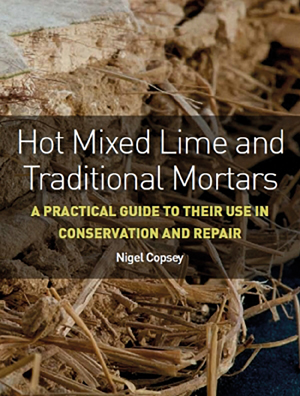 Hot Mixed Lime and Traditional Mortars
Hot Mixed Lime and Traditional Mortars
ISBN: 9781785005558
PAGES: 176
BINDING: Paperback
INSIDE: 286 colour photographs and 11 line artworks
AUTHOR: Nigel Copsey
PUBLISHER: The Crowood Press
PRICE: £25
The author: Nigel Copsey began working with stone as a drystone waller in Cornwall. He went on to train as a stonemason and carver at Weymouth College in Dorset, becoming established as a lettercutter and stonemason working mainly in building conservation. Based originally in the South-West and now in North Yorkshire, his company, Earth Stone & Lime Company & Associates, has carried out projects across England and, lately, abroad. Nigel is a fully accredited member of the United Kingdom Institute of Conservation and on the committee of the Building Limes Forum.
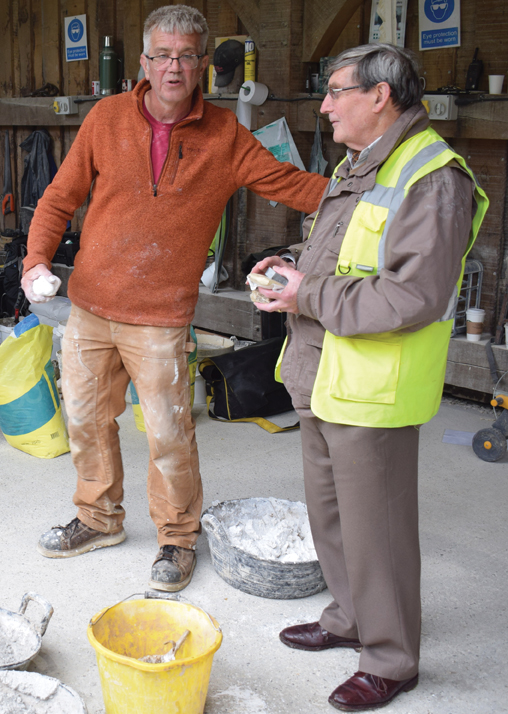
Nigel Copsey (left) with Stafford Holmes, a consultant with architects Rodney Melville & Partners and fellow committee member of the Building Limes Forum, at the Forum’s three-day symposium on hot lime and earth mortars in York last year, which attracted international participation as the world re-learns the knowledge possessed by previous generations of masons.

